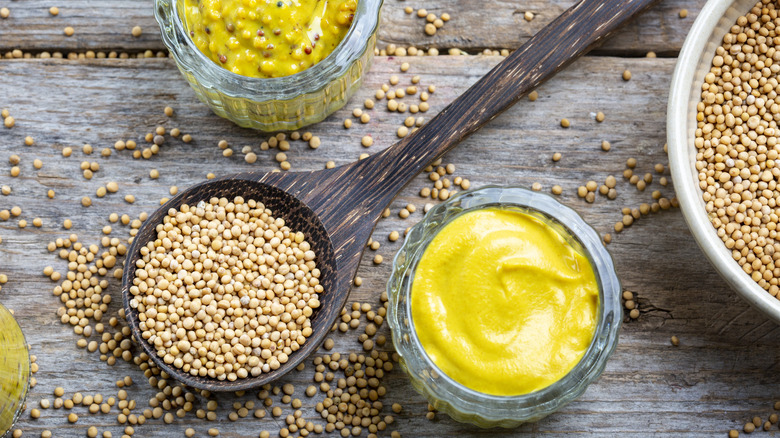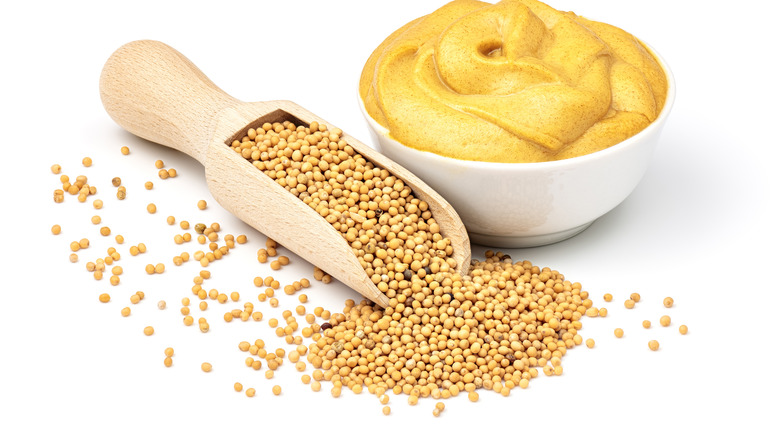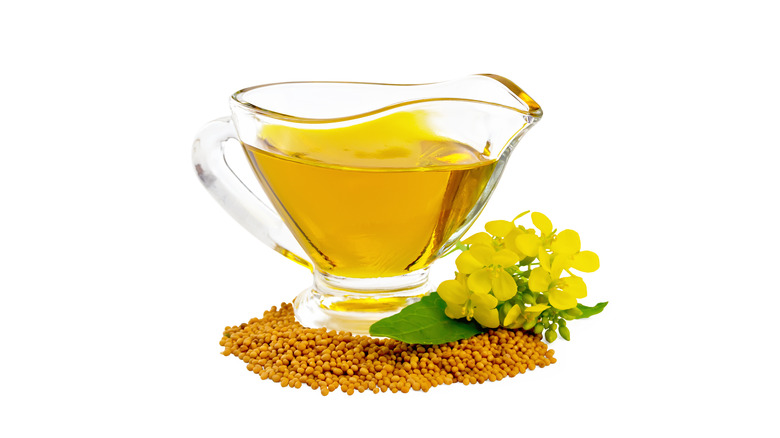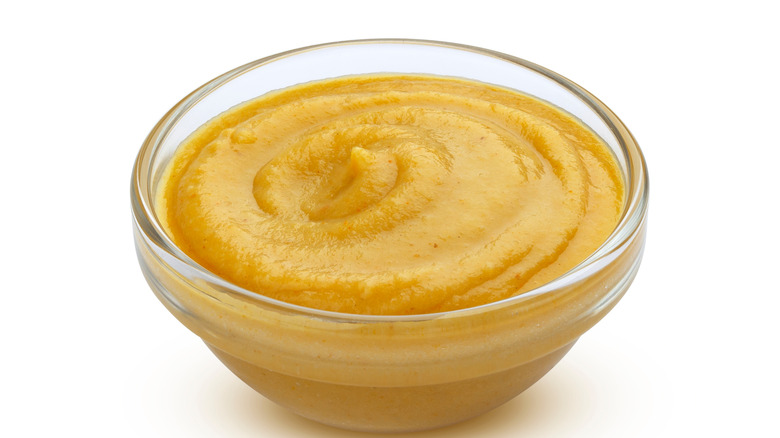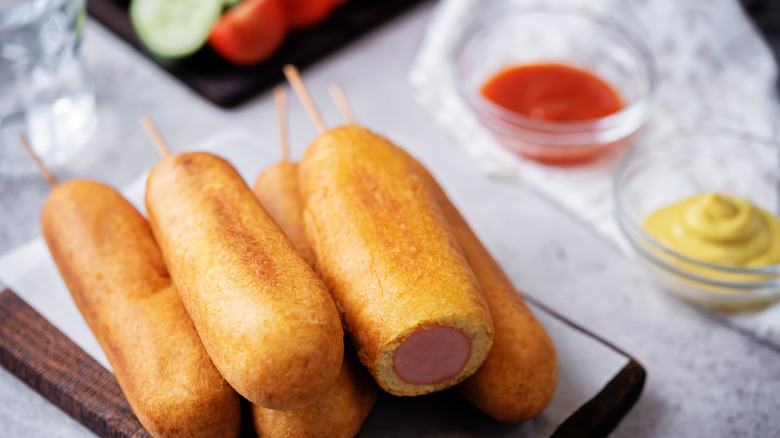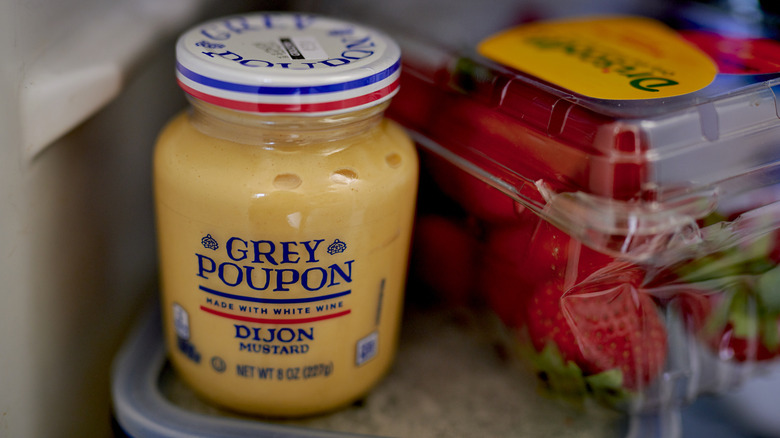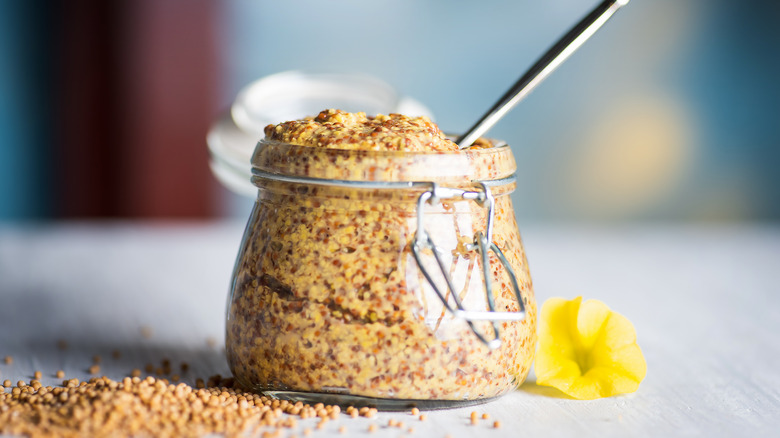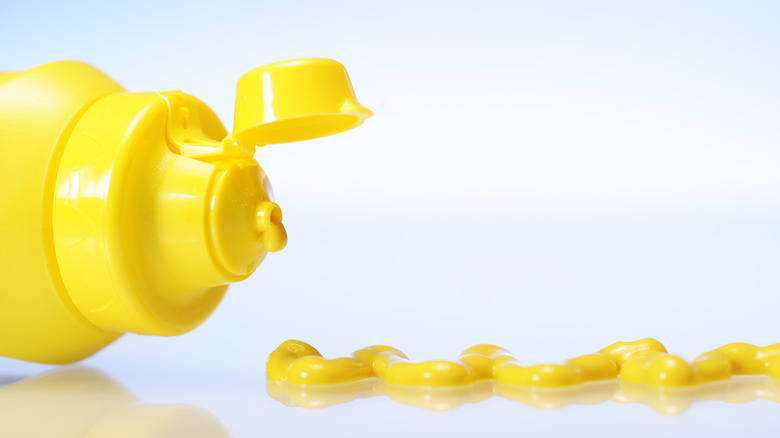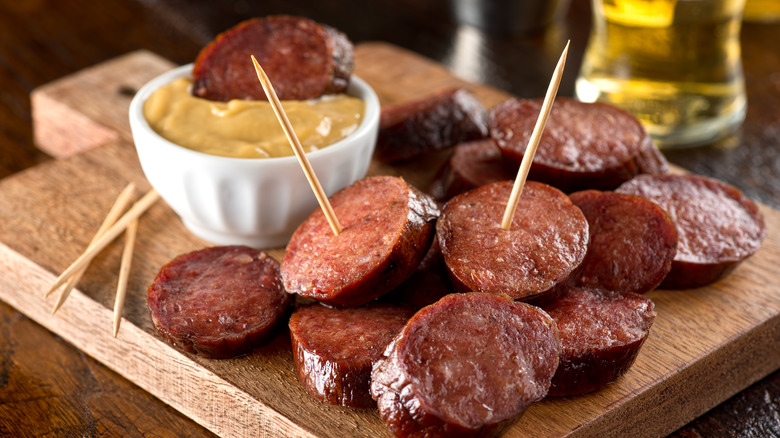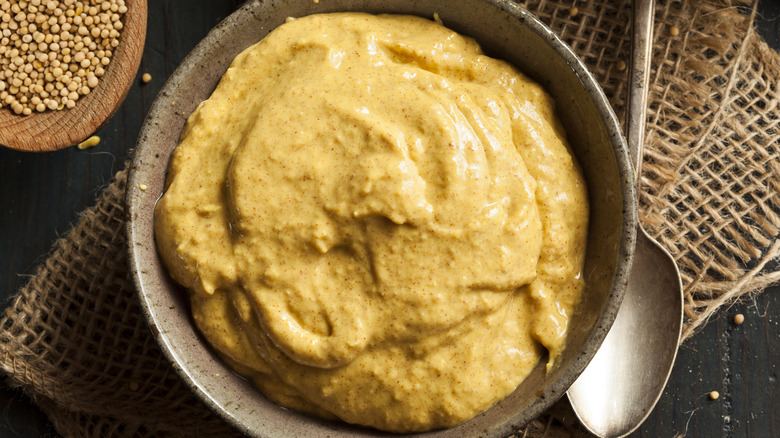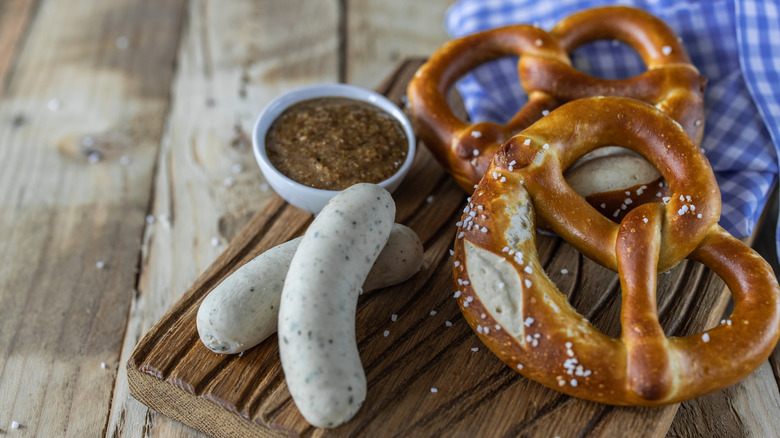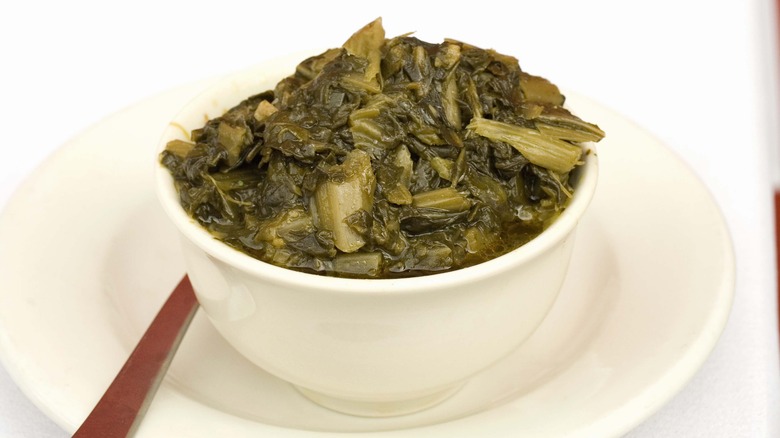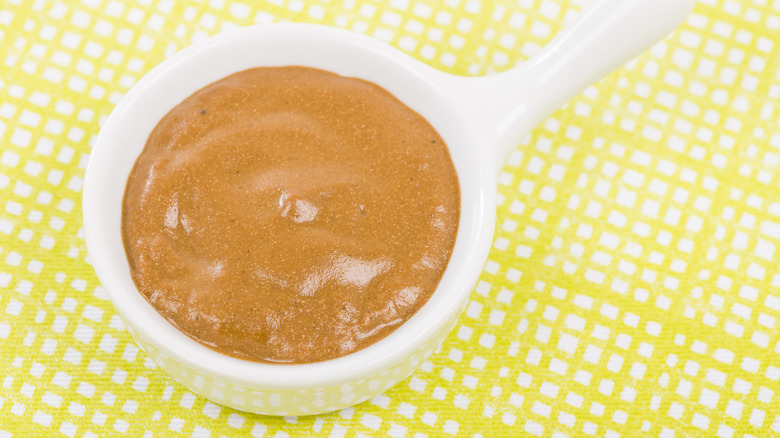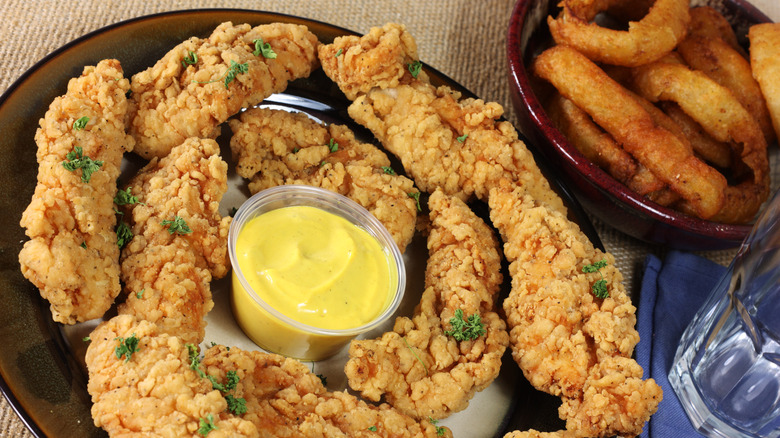A Guide To All The Different Kinds Of Mustard
One of the earliest recorded spices, mustard has been valued for its enticing bite for thousands of years — the first written record of it appears in Sanskrit manuscripts dating to 3000 B.C. It's thought to be among the first plants to be domesticated and has been enjoyed as a spicy condiment since ancient times. Indeed, the very word "mustard" comes from the Latin term mustum ardens, or burning must. This referred to both the stinging hotness of ground mustard seeds as well as the ancient custom of combining these ground seeds with must, the juice of wine grapes.
But, mustard wasn't just valued for its flavor — it was historically used around the world as a medicine and was thought to have the power to heal everything from bubonic plague to snake bites and hysteria. Mustard seed oil, as well as poultices made from ground mustard seeds, were also used as topical treatments, serving as massage oils, hair treatments, and remedies for skin conditions and inflammation. Modern science has proven there was something to these ancient traditions, confirming that mustard has anti-microbial properties and can help mitigate the effects of diabetes. Little of this matters to modern diners, however — all we know is no hot dog or soft pretzel will taste right without it. But, there's way more to mustard than the familiar, yellow squeeze bottle. Here are some of the many varieties of mustard enjoyed around the world.
Mustard seeds
We'll start with the basics: At the heart of every spreadable mustard are ground mustard seeds, which provide the condiment's characteristic bite and aroma. The seeds themselves are used around the world as a seasoning in their own right, adding a unique, nutty flavor you might not immediately recognize as mustard. In the Bengali region of India, for example, black mustard seeds are a common flavoring for fish, and in other parts of India, mustard seeds are a common flavoring for yogurt-based sauces, rice, and curries. A common technique for showcasing the flavor of mustard seeds is to lightly fry the seeds along with a handful of curry leaves in oil, then fold this aromatic oil into rice or yogurt or toss it into cooked dishes.
Mustard seeds are also used in other cuisines and make regular appearances in familiar dishes such as pickles, where they're added to the pickling brine, as well as cured meats such as corned beef, where mustard seeds (along with coriander seeds, juniper berries, and black pepper) are used in the curing process. They can also be enjoyed as a condiment on their own — simmered in a mixture of vinegar, water, and brown sugar, they become pickled mustard seeds or mustard caviar, a vibrant, close cousin of grainy mustard that makes for a refreshing changeup from regular mustard.
Mustard oil
Mustard oil is an often-overlooked flavoring, but if you have an adventurous palate, it's worth seeking out. Popular in many Asian cuisines (it's a signature flavor in the cooking of West Bengal in India as well as in Pakistan and Bangladesh), it has a distinctive bite reminiscent of wasabi that's even more intense when the oil is heated. It can be used in a number of ways — as a flavoring in pickling brines, as a frying medium, and as a flavor accent for salad dressings and other dishes.
Enticing as mustard oil may be, it's never become a popular condiment in the U.S. There's a good reason for this: If you venture into an Indian specialty market and find mustard oil, every single bottle will be labeled "for external use only." This is because mustard oil contains high levels of erucic acid, a fatty acid (also found in related plants such as kale) that was found in animal-based experiments in the 1950s to be associated with heart disease. Out of an abundance of caution, the U.S. banned mustard oil for human consumption. It's worth noting, however, that more recent human-based studies on the effects of erucic acid have been inconclusive, and Asian diners have been cooking with and enjoying mustard oil with no apparent ill effect for centuries. And, legally food-safe varieties of mustard oil have recently become available online if you want to be cautious but still want to experience a nice blast of heat.
English mustard
Oftentimes, traditional English cooks welcome a bit of spice as an accent to simply flavored dishes; the English fondness for tangy chutneys is a case in point. Another popular condiment for livening up plain, meaty dishes is English mustard, which is even hotter and more pungent than the varieties favored in mustard-loving locales such as the U.S. and Germany. Its intense bite makes it a memorable way to liven up a plain piece of meat or a cheese sandwich.
What gives English mustard its characteristic flavor is its preparation. It's made from a combination of brown and yellow mustard seeds, which are ground and powdered. (Colman's is a popular brand of English mustard). For serving, it's simply mixed with water. One thing you won't notice, though, is the characteristic vinegar tang of some other prepared mustards. Vinegar is added to other varieties of mustard both as a flavor accent and to tame the mustard's inherent heat, so without it here, the unfiltered hotness of the ground mustard is able to truly shine.
Chinese hot mustard
If you've ever enjoyed a dim sum brunch at a Cantonese restaurant, you probably noticed tiny dishes of mustard (and sometimes ketchup or hot sauce) on the table along with your dumplings. If you tasted the mustard, you knew immediately you weren't dealing with your standard ballpark mustard. If traditional English mustard is seriously hot, Chinese mustard is even hotter and meant to be enjoyed in tiny doses.
Chinese mustard is prepared in much the same way as English mustard, with a powder of dried, ground mustard seeds simply mixed with water. However, there is one major difference: While English mustard uses a combination of mild yellow mustard seeds and hotter brown seeds, Chinese mustard uses the hotter, brown mustard seeds only. Some Chinese dry mustard powders contain other ingredients, such as turmeric (for coloring) and flour (to cut the bite for more timid palates). Traditionally, it's used almost exclusively as a table condiment to add a spicy accent to dishes such as egg rolls and dumplings.
Dijon mustard
Dijon mustard is not only one of the most familiar types of mustard to American diners but one of the oldest. The Dijon region of France was the first to prepare and sell mustard as we currently know it, starting commercial mustard production in the 13th century. This move was said to have been inspired by Pope John XXII, seated in Avignon, who was such a hardcore mustard lover he created an official position, Grand Moutardier du Pape ("Grand Mustard-maker to the Pope") to ensure his cravings could be regularly met.
The pope was not the only fan of locally made mustard, which gained popularity for both its gently lingering heat and smoothness. Traditionally, it was made with ground brown mustard seeds mixed with verjus (the juice of unripe grapes), which lends not only a characteristic flavor but a more intense heat than mustards made with more acidic liquids such as vinegar. Today, many Dijon-style mustards are made with white wine or other low-acid liquids. Hotter than standard yellow mustard but less hot than the super-intense Chinese or English varieties, Dijon is a great condiment to have on hand for sandwiches, salad dressings, and other dishes where a bit of punch is welcome.
Whole grain mustard
The nubby texture of whole-grain mustard gives it a rustic vibe that makes it feel like an ancient and elemental condiment. It's easy to picture cooks in ancient times stirring whole mustard seeds straight from the plant into some liquid and creating this flavorful preparation. In reality, however, whole-grain mustard is a fairly new innovation, likely dating to the early 1970s or shortly before. Unlike other mustards, which are made by thoroughly grinding mustard seeds before mixing them into acidic liquids such as wine or vinegar, whole-grain mustards leave some (but not all) of the mustard seeds whole, allowing them to add crunch and visual contrast to the finished condiment.
Counterintuitively, whole-grain mustard is actually less hot than smoother mustards. This is because grinding mustard seeds causes sinigrin — the compound that contributes mustard's characteristic hotness — to degrade, a reaction that releases the mustard seed's hotness. Whole grains, on the other hand, do not undergo this process and thus contribute a milder taste. So if you're looking for textural contrast, rather than heat, to complement your next sandwich or salad dressing, reach for the whole-grain mustard.
American yellow mustard
If you grew up in the U.S., chances are that your first taste of mustard was highlighter yellow and mildly hot with a distinctive, vinegar tang. Made with white mustard seeds, the most mildly flavored of the seed types, it has a bold flavor but just a hint of hotness — enough to cut the fattiness of a hot dog without being too hot for kids to enjoy. Vinegar contributes its distinctive bold, tangy flavor, and its yellow color comes not just from the mustard itself, but also from turmeric, the spice that contributes the bright yellow color to many curries. This is also why classic American mustard, more than any other type, is notorious for staining everything it touches.
Yellow mustard was introduced in 1904 by the R.T. French Company (French's is still a major manufacturer of yellow mustard) and first served by the company at that year's World's Fair in St. Louis. While too bold and distinctive for use in most sauces (where Dijon would be a better choice), yellow mustard is still a must have anywhere hot dogs or hamburgers are served, such as cookouts and, of course, ballparks.
Beer mustard
Beer mustard sounds like a classic German preparation — after all, Germany is famed for its beer and beer culture, as well as for its mustards and mustard-friendly foods such as sausages. But, while many different varieties of mustard originated in Germany — from spicy brown mustards to sweet ones – beer mustard was actually an American innovation, albeit one created by German immigrants familiar with mustard-making traditions.
In beer mustard, beer replaces most of the acid (such as wine or vinegar) usually used to moisten and flavor the ground mustard seeds in other spreadable mustards. This contributes to the distinctive flavor of beer mustard in a couple of ways. For one, the beer itself adds nutty, mildly bitter notes. Most critically, however, the lower acidity of beer ensures the mustard retains its natural hotness. Acids such as vinegar can tame this heat, resulting in milder mustards. If you're looking for a spicy, nutty mustard to enliven your next sausage feast, look no further than beer mustard.
Brown mustard
Brown mustard, sometimes called spicy brown mustard, lives up to its name. Made with brown mustard seeds or sometimes a combination of brown and yellow mustard seeds, it's hotter than standard yellow mustard. It also has a different texture, traditionally more coarse and less uniform than yellow or Dijon mustards. This gives it a distinctly hearty vibe that makes it a good partner for rich, strongly flavored meats such as pastrami.
Another distinctive feature of spicy brown mustard is its flavor profile — besides the heat from the mustard itself, it gets its spice from warm flavorings such as ginger, cinnamon, and nutmeg. While mustard is not something most people think to make at home, it's actually pretty straightforward to prepare. All you need to do is macerate mustard seeds in vinegar for a day, then blend with salt, any desired spices, and as much water as you need to get your desired consistency. You'll not only get bragging rights but also the ability to create mustard with any flavor profile you like.
Bavarian sweet mustard
Different regions of Germany are known for specializing in their own types of mustard. For instance, Mittelscharf, or medium-hot mustard, made from a blend of brown and yellow mustard seeds, is common and popular across Germany, while the region around Dusseldorf is known for hotter, spicier, but less-acidic varieties. In Bavaria, the mustard of choice is sweet mustard made with a combination of yellow and brown mustard seeds and sweetened with brown sugar, honey, applesauce, and/or apple juice, depending on the recipe and the cook.
Sweet mustard is also indelibly associated with a couple of other Bavarian traditions. For one, it's such a common condiment with weisswurst, a type of mild white Bavarian sausage, that it's often called weisswurst mustard. It's also the go-to condiment during Oktoberfest when beer and food lovers from around the world throng into Munich to enjoy traditional foods such as ham hocks, pretzels, roast chicken, and, of course, weisswurst. All of these dishes taste even better with a dab of sweet mustard and a cold, locally made beer to wash it all down.
Mustard greens
The seeds aren't the only part of the mustard plant worth eating. As cooks in Asia and the American South have long known, mustard greens — the leaves of the same plant — also pack a memorable punch. Related to vegetables such as cabbage, kale, broccoli, and cauliflower, mustard greens have a similar assertive flavor as their relatives with an additional spicy, mustardy bite.
Because mustard greens have a hearty texture along with their powerful flavor, they stand up well to long cooking and are great paired with equally assertive flavorings. For instance, Southern cooks have traditionally prepared mustard (and other greens) by slowly stewing them with ham hocks until meltingly soft. For an adventurous dish, try out Jenn Louis' recipe for mustard green pancakes. Another flavorful option is Indian-style mustard greens, which are blanched, pureed, then stewed with garlic, ginger, onions, and chiles. If you're not sure you'd enjoy such an assertively flavored veggie, try simmering it in a cream sauce or adding a handful to a mild white bean stew.
Creole mustard
New Orleans (and Louisiana in general) is known for its culinary traditions, and the city's cooks are famous for putting their own spin on dishes and ingredients from the cultures that historically settled in the region. While best known for its French-influenced dishes, Indigenous Americans, enslaved people, and immigrants from other countries also made important contributions that helped define Creole cuisine. And among these innovators was a German settler reportedly named Mr. Wolff who made and sold his own mustard door to door in New Orleans. His mustard became so popular it eventually went into large-scale production, with competing factories each producing their own version of the condiment.
Creole mustard is known for its hotness, largely because it's made with hotter, brown mustard seeds and unlike many other types of commercial mustard, it doesn't contain any flour (which is often used as a filler to control the heat of the mustard). It also has a hint of sweetness from molasses or brown sugar, and some versions may be flavored with horseradish, giving the already hot mustard an extra kick. Spices such as allspice, cayenne, and garlic add even more zing to this beloved condiment.
Honey mustard
Not so much a mustard type in its own right as an indispensable mustard hack, honey mustard is a sweet, spicy, family-friendly condiment that's great with chicken fingers, sandwiches, or as a dip for veggies. It also makes a great salad dressing and glaze and has become so popular that snacks ranging from pretzels to potato chips now come with honey mustard flavoring.
The name alone can tell you what the key ingredients in honey mustard are — to make a bare-bones (but plenty flavorful) version, just mix your favorite mustard (plain yellow and Dijon are popular choices, and most people have one of these in their fridge) with honey to taste to get your preferred balance of spice and sweetness. You can also create a creamier, more complexly flavored version of honey mustard by adding mayonnaise and vinegar for added sharpness, and garlic and paprika for a hint of spice. Yes, you can buy bottled versions, but if you have honey, mustard, and a clean spoon lying around, it'll be even faster to make your own.

